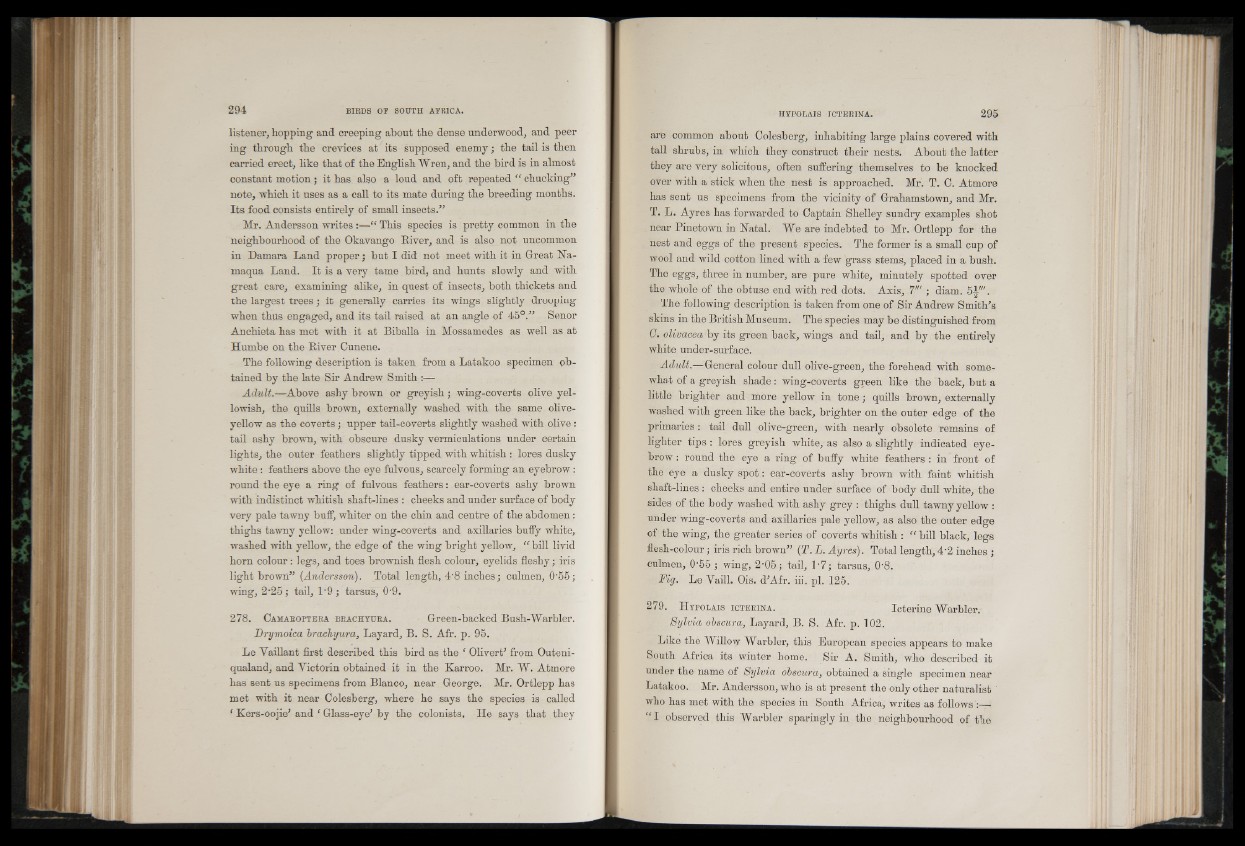
listener, hopping and creeping about the dense underwood, and peer
ing through the crevices at its supposed enemy; the tail is then
carried erect, like that of the English Wren, and the bird is in almost
constant motion; it has also a loud and oft repeated “ chucking”
note, which it uses as a call to its mate during the breeding months.
Its food consists entirely of small insects/ 1
Mr. Andersson writes :—“ This species is pretty common in the
neighbourhood of the Okavango River, and is also not uncommon
in Damara Land proper; but I did not meet with it in Great Na-
maqua Land. It is a very tame bird, and hunts slowly and with
great care, examining alike, in quest of insects, both thickets and
the largest trees; it generally carries its wings slightly drooping
when thus engaged, and its tail raised at an angle of 45°.” Senor
Anchieta has met with it at Biballa in Mossamedes as well as at
Humbe on the River Cunene.
The following description is taken from a Latakoo specimen obtained
by the late Sir Andrew Smith :—
Adult.—Above ashy brown or greyish; wing-coverts olive yellowish,
the quills brown, externally washed with the same olive-
yellow as the coverts; upper tail-coverts slightly washed with olive :
tail ashy brown, with obscure dusky vermiculations under certain
lights, the outer feathers slightly tipped with whitish : lores dusky
white: feathers above the eye fulvous, scarcely forming an eyebrow :
round the eye a ring of fulvous feathers: ear-coverts ashy brown
with indistinct whitish shaft-lines : cheeks and under surface of body
very pale tawny buff, whiter on the chin and centre of the abdomen:
thighs tawny yellow: under wing-coverts and axillaries buffy white,
washed with yellow, the edge of the wing bright yellow, “ bill livid
horn colour: legs, and toes brownish flesh colour, eyelids fleshy; iris
light brown” (Andersson). Total length, 4'8 inches; culmen, 0-55;
wing, 2-25; tail, 1'9; tarsus, 0'9.
278. Camaroptera b rachyura. Green-backed Bush-Warbler.
Drymoica brachyura, Layard, B. S. Afr. p. 95.
Le Yaillant first described this bird as the ‘ d ivert1 from Outeni-
qualand, and Yictoiin obtained it in the Karroo. Mr. W. Atmore
has sent us specimens from Blanco, near George. Mr. Ortlepp has
met with it near Colesberg, where he says the species is called
‘ Kers-oojie1 and ‘ Glass-eye1 by the colonists. He says that they
are common about Colesberg, inhabiting large plains covered with
tall shrubs, in which they construct their nests. About the latter
they are very solicitous, often suffering themselves to be knocked
over with a stick when the nest is approached. Mr. T. C. Atmore
has sent us specimens from the vicinity of Grahamstown, and Mr.
T. L. Ayres has forwarded to Captain Shelley sundry examples shot
near Pinetown in Natal. We are indebted to Mr. Ortlepp for the
nest and eggs of the present species. The former is a small cup of
wool and wild cotton lined with a few grass stems, placed in a bush.
The eggs, three in number, are pure white, minutely spotted over
the whole of the obtuse end with red dots. Axis, T" ; diam. .
The following description is taken from one of Sir Andrew Smith/s
skins in the British Museum. The species may be distinguished from
G. olivacea by its green back, wings and tail, and by the entirely
white under-surface.
Adult.—General colour dull olive-green, the forehead with somewhat
of a greyish shade: wing-coverts green like the back, but a
little brighter and more yellow in tone; quills brown, externally
washed with green like the back, brighter on the outer edge of the
primaries : tail dull olive-green, with nearly obsolete remains of
lighter tips : lores greyish white, as also a slightly indicated eyebrow
: round the eye a ring of buffy white feathers : in front of
the eye a dusky spot: ear-coverts ashy brown with, faint whitish
shaft-lines : cheeks and entire under surface of body dull white, the
sides of the body washed with ashy grey : thighs dull tawny yellow :
under wing-coverts and axillaries pale yellow, as also the outer edge
of the wing, the greater series of coverts whitish : “ bill black, legs
flesh-colour; iris rich brown” (T . L. Ayres). Total length, 4'2 inches ;
culmen, 0'55; wing, 2-05; tail, P7; tarsus, 08.
Fig. Le Yaill. Ois. d'Afr. iii. pi. 125.
279. H y p o l a is ic t e r in a . Icterine Warbler.
Sylvia obscura, Layard, B. S. Afr. p. 102.
Like the Willow Warbler, this European species appears to make
South Africa its winter home. Sir A. Smith, who described it
under the name of Sylvia obscura, obtained a single specimen near
Latakoo. Mr. Andersson, who is at present the only other naturalist
who has met with the species in South Africa, writes as follows :__
“ I observed this Warbler sparingly in the neighbourhood of the